Strategic Supply Chain Management Process at Sainsbury's Supermarket
VerifiedAdded on 2023/01/16
|18
|4701
|21
Report
AI Summary
This report provides a comprehensive analysis of Sainsbury's supply chain management, examining its current network, particularly focusing on the Just-in-Time (JIT) model and its implications for the retail giant. It delves into the strategic role of Sainsbury's, highlighting the application of the six sigma model to understand market structure and implement effective strategies. The report explores various aspects, including cost accounting, partnerships, data integration, security enhancements, and open supply chain standards. Furthermore, it investigates customer and supplier relationship management theories and time-based supply chain management, identifying both strengths and drawbacks of the implemented models. Finally, the report concludes with recommendations for future improvements in Sainsbury's supply chain operations, aiming to enhance efficiency and competitiveness within the market.
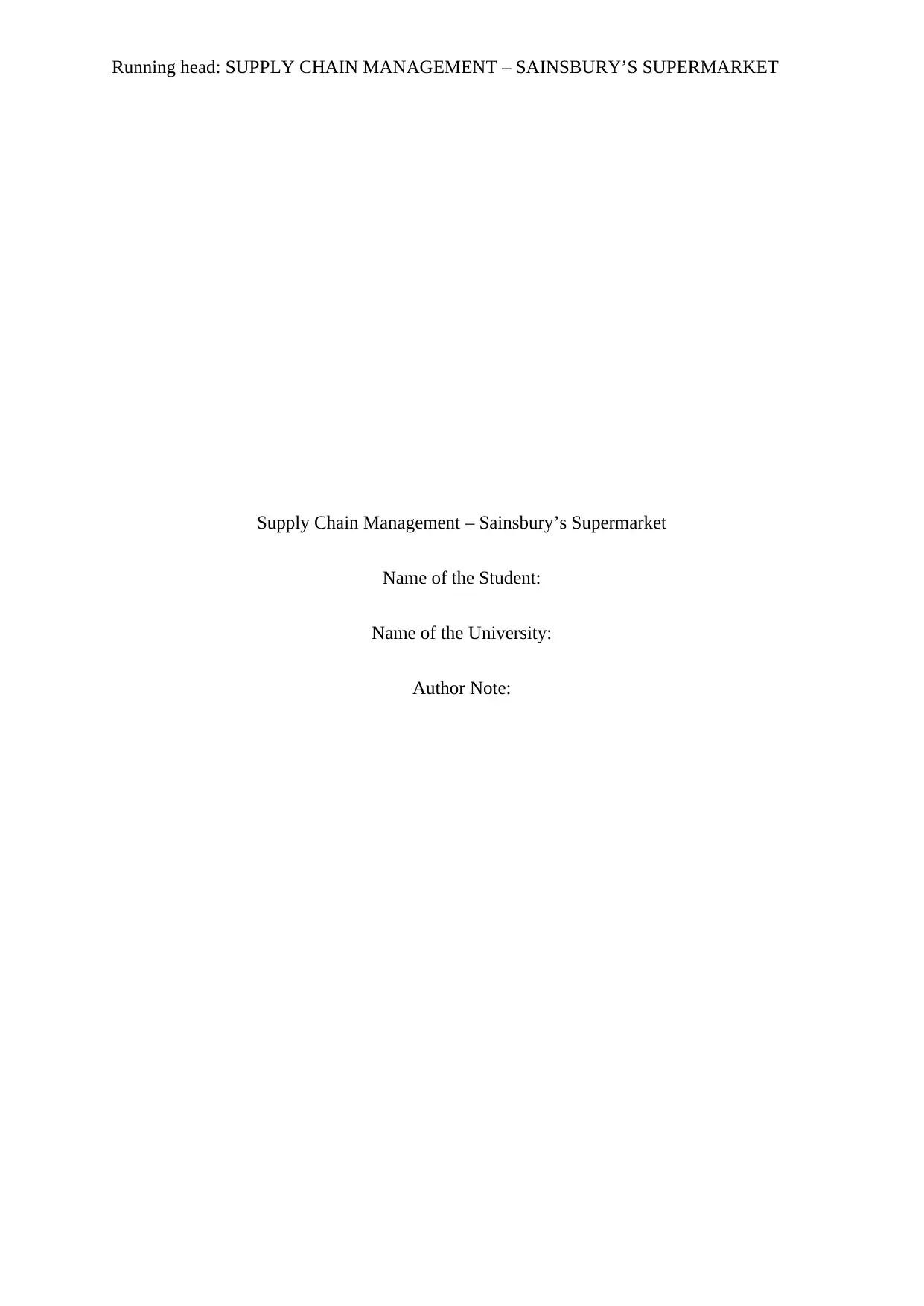
Running head: SUPPLY CHAIN MANAGEMENT – SAINSBURY’S SUPERMARKET
Supply Chain Management – Sainsbury’s Supermarket
Name of the Student:
Name of the University:
Author Note:
Supply Chain Management – Sainsbury’s Supermarket
Name of the Student:
Name of the University:
Author Note:
Paraphrase This Document
Need a fresh take? Get an instant paraphrase of this document with our AI Paraphraser
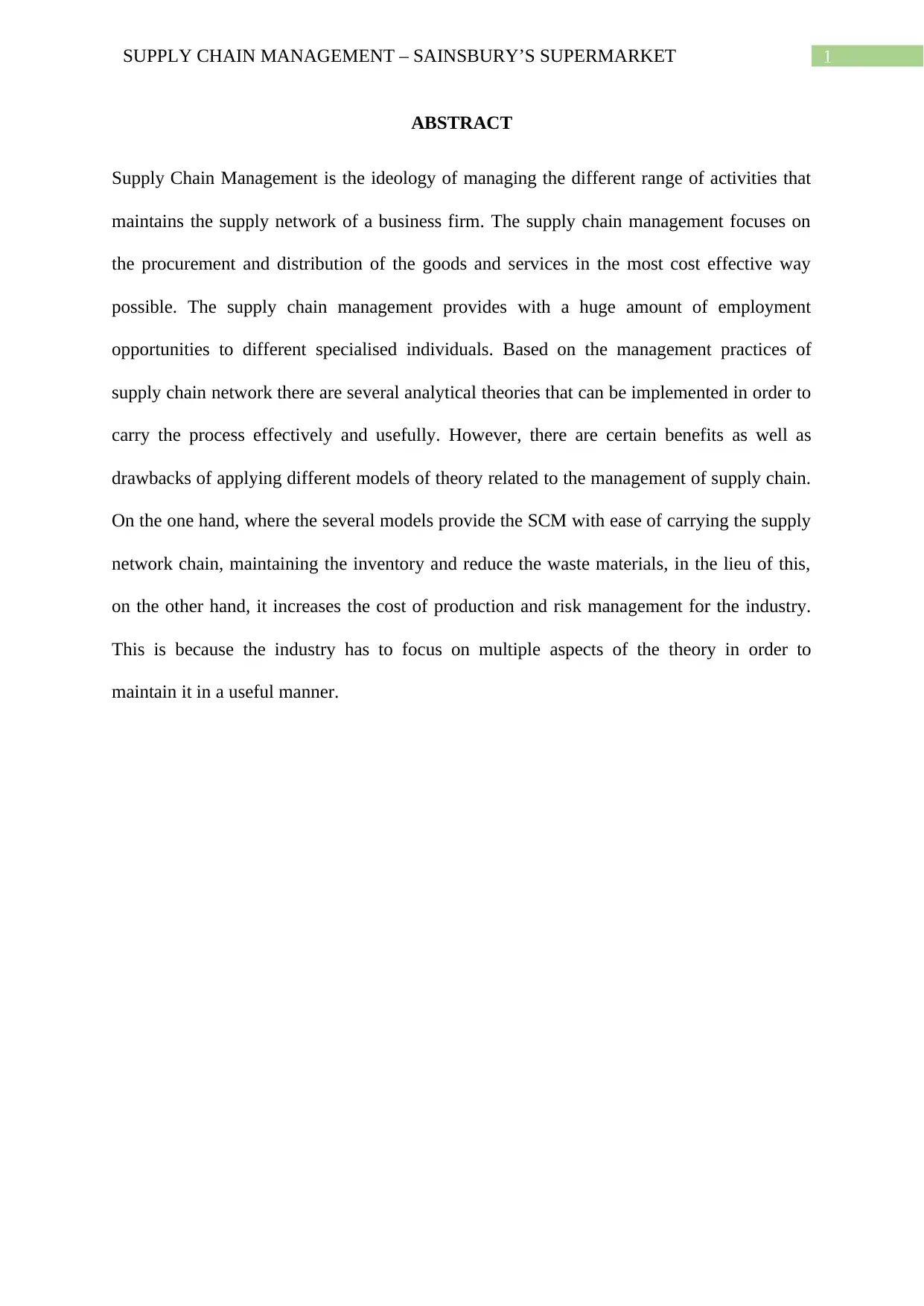
1SUPPLY CHAIN MANAGEMENT – SAINSBURY’S SUPERMARKET
ABSTRACT
Supply Chain Management is the ideology of managing the different range of activities that
maintains the supply network of a business firm. The supply chain management focuses on
the procurement and distribution of the goods and services in the most cost effective way
possible. The supply chain management provides with a huge amount of employment
opportunities to different specialised individuals. Based on the management practices of
supply chain network there are several analytical theories that can be implemented in order to
carry the process effectively and usefully. However, there are certain benefits as well as
drawbacks of applying different models of theory related to the management of supply chain.
On the one hand, where the several models provide the SCM with ease of carrying the supply
network chain, maintaining the inventory and reduce the waste materials, in the lieu of this,
on the other hand, it increases the cost of production and risk management for the industry.
This is because the industry has to focus on multiple aspects of the theory in order to
maintain it in a useful manner.
ABSTRACT
Supply Chain Management is the ideology of managing the different range of activities that
maintains the supply network of a business firm. The supply chain management focuses on
the procurement and distribution of the goods and services in the most cost effective way
possible. The supply chain management provides with a huge amount of employment
opportunities to different specialised individuals. Based on the management practices of
supply chain network there are several analytical theories that can be implemented in order to
carry the process effectively and usefully. However, there are certain benefits as well as
drawbacks of applying different models of theory related to the management of supply chain.
On the one hand, where the several models provide the SCM with ease of carrying the supply
network chain, maintaining the inventory and reduce the waste materials, in the lieu of this,
on the other hand, it increases the cost of production and risk management for the industry.
This is because the industry has to focus on multiple aspects of the theory in order to
maintain it in a useful manner.
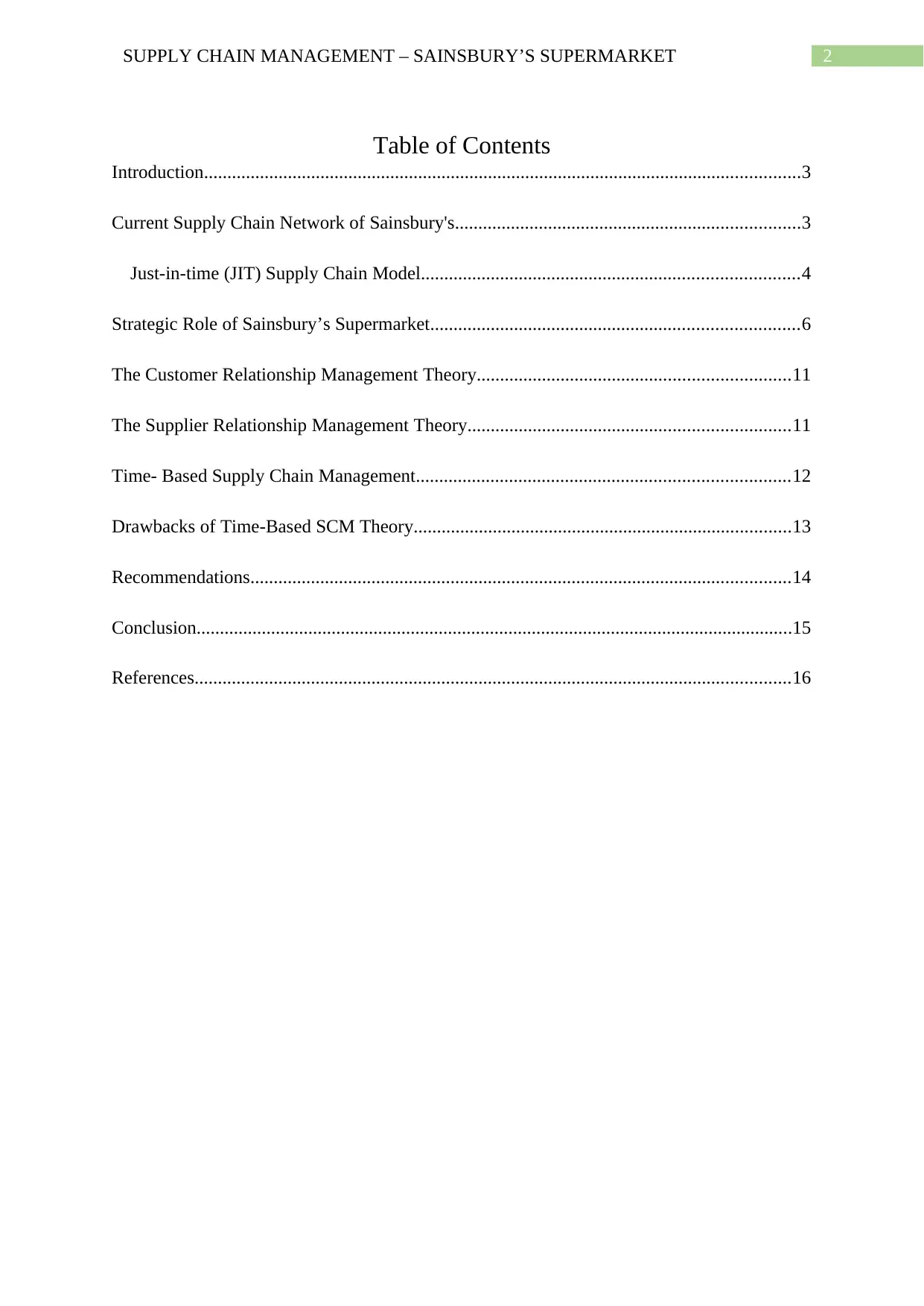
2SUPPLY CHAIN MANAGEMENT – SAINSBURY’S SUPERMARKET
Table of Contents
Introduction................................................................................................................................3
Current Supply Chain Network of Sainsbury's..........................................................................3
Just-in-time (JIT) Supply Chain Model.................................................................................4
Strategic Role of Sainsbury’s Supermarket...............................................................................6
The Customer Relationship Management Theory...................................................................11
The Supplier Relationship Management Theory.....................................................................11
Time- Based Supply Chain Management................................................................................12
Drawbacks of Time-Based SCM Theory.................................................................................13
Recommendations....................................................................................................................14
Conclusion................................................................................................................................15
References................................................................................................................................16
Table of Contents
Introduction................................................................................................................................3
Current Supply Chain Network of Sainsbury's..........................................................................3
Just-in-time (JIT) Supply Chain Model.................................................................................4
Strategic Role of Sainsbury’s Supermarket...............................................................................6
The Customer Relationship Management Theory...................................................................11
The Supplier Relationship Management Theory.....................................................................11
Time- Based Supply Chain Management................................................................................12
Drawbacks of Time-Based SCM Theory.................................................................................13
Recommendations....................................................................................................................14
Conclusion................................................................................................................................15
References................................................................................................................................16
⊘ This is a preview!⊘
Do you want full access?
Subscribe today to unlock all pages.

Trusted by 1+ million students worldwide
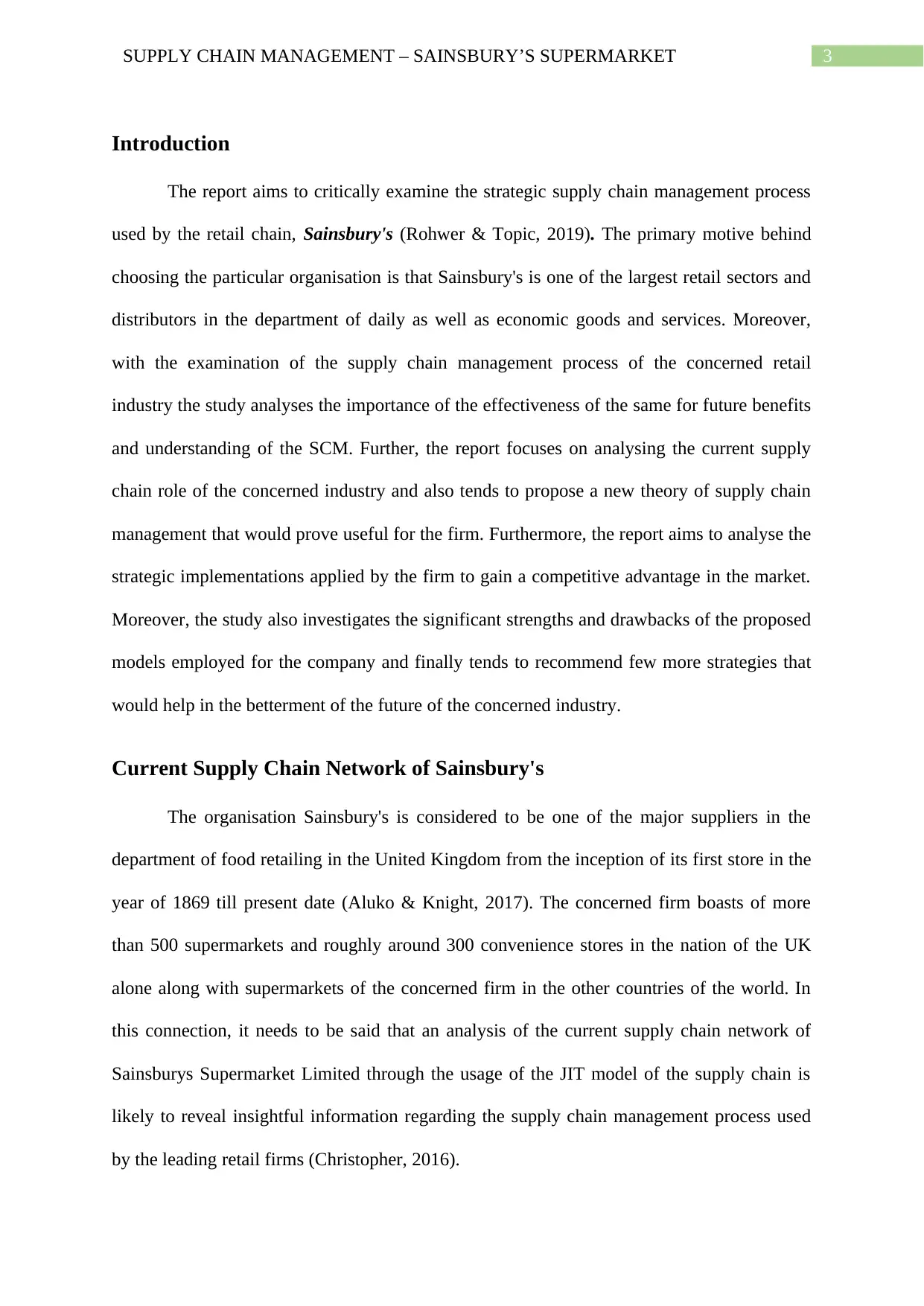
3SUPPLY CHAIN MANAGEMENT – SAINSBURY’S SUPERMARKET
Introduction
The report aims to critically examine the strategic supply chain management process
used by the retail chain, Sainsbury's (Rohwer & Topic, 2019). The primary motive behind
choosing the particular organisation is that Sainsbury's is one of the largest retail sectors and
distributors in the department of daily as well as economic goods and services. Moreover,
with the examination of the supply chain management process of the concerned retail
industry the study analyses the importance of the effectiveness of the same for future benefits
and understanding of the SCM. Further, the report focuses on analysing the current supply
chain role of the concerned industry and also tends to propose a new theory of supply chain
management that would prove useful for the firm. Furthermore, the report aims to analyse the
strategic implementations applied by the firm to gain a competitive advantage in the market.
Moreover, the study also investigates the significant strengths and drawbacks of the proposed
models employed for the company and finally tends to recommend few more strategies that
would help in the betterment of the future of the concerned industry.
Current Supply Chain Network of Sainsbury's
The organisation Sainsbury's is considered to be one of the major suppliers in the
department of food retailing in the United Kingdom from the inception of its first store in the
year of 1869 till present date (Aluko & Knight, 2017). The concerned firm boasts of more
than 500 supermarkets and roughly around 300 convenience stores in the nation of the UK
alone along with supermarkets of the concerned firm in the other countries of the world. In
this connection, it needs to be said that an analysis of the current supply chain network of
Sainsburys Supermarket Limited through the usage of the JIT model of the supply chain is
likely to reveal insightful information regarding the supply chain management process used
by the leading retail firms (Christopher, 2016).
Introduction
The report aims to critically examine the strategic supply chain management process
used by the retail chain, Sainsbury's (Rohwer & Topic, 2019). The primary motive behind
choosing the particular organisation is that Sainsbury's is one of the largest retail sectors and
distributors in the department of daily as well as economic goods and services. Moreover,
with the examination of the supply chain management process of the concerned retail
industry the study analyses the importance of the effectiveness of the same for future benefits
and understanding of the SCM. Further, the report focuses on analysing the current supply
chain role of the concerned industry and also tends to propose a new theory of supply chain
management that would prove useful for the firm. Furthermore, the report aims to analyse the
strategic implementations applied by the firm to gain a competitive advantage in the market.
Moreover, the study also investigates the significant strengths and drawbacks of the proposed
models employed for the company and finally tends to recommend few more strategies that
would help in the betterment of the future of the concerned industry.
Current Supply Chain Network of Sainsbury's
The organisation Sainsbury's is considered to be one of the major suppliers in the
department of food retailing in the United Kingdom from the inception of its first store in the
year of 1869 till present date (Aluko & Knight, 2017). The concerned firm boasts of more
than 500 supermarkets and roughly around 300 convenience stores in the nation of the UK
alone along with supermarkets of the concerned firm in the other countries of the world. In
this connection, it needs to be said that an analysis of the current supply chain network of
Sainsburys Supermarket Limited through the usage of the JIT model of the supply chain is
likely to reveal insightful information regarding the supply chain management process used
by the leading retail firms (Christopher, 2016).
Paraphrase This Document
Need a fresh take? Get an instant paraphrase of this document with our AI Paraphraser
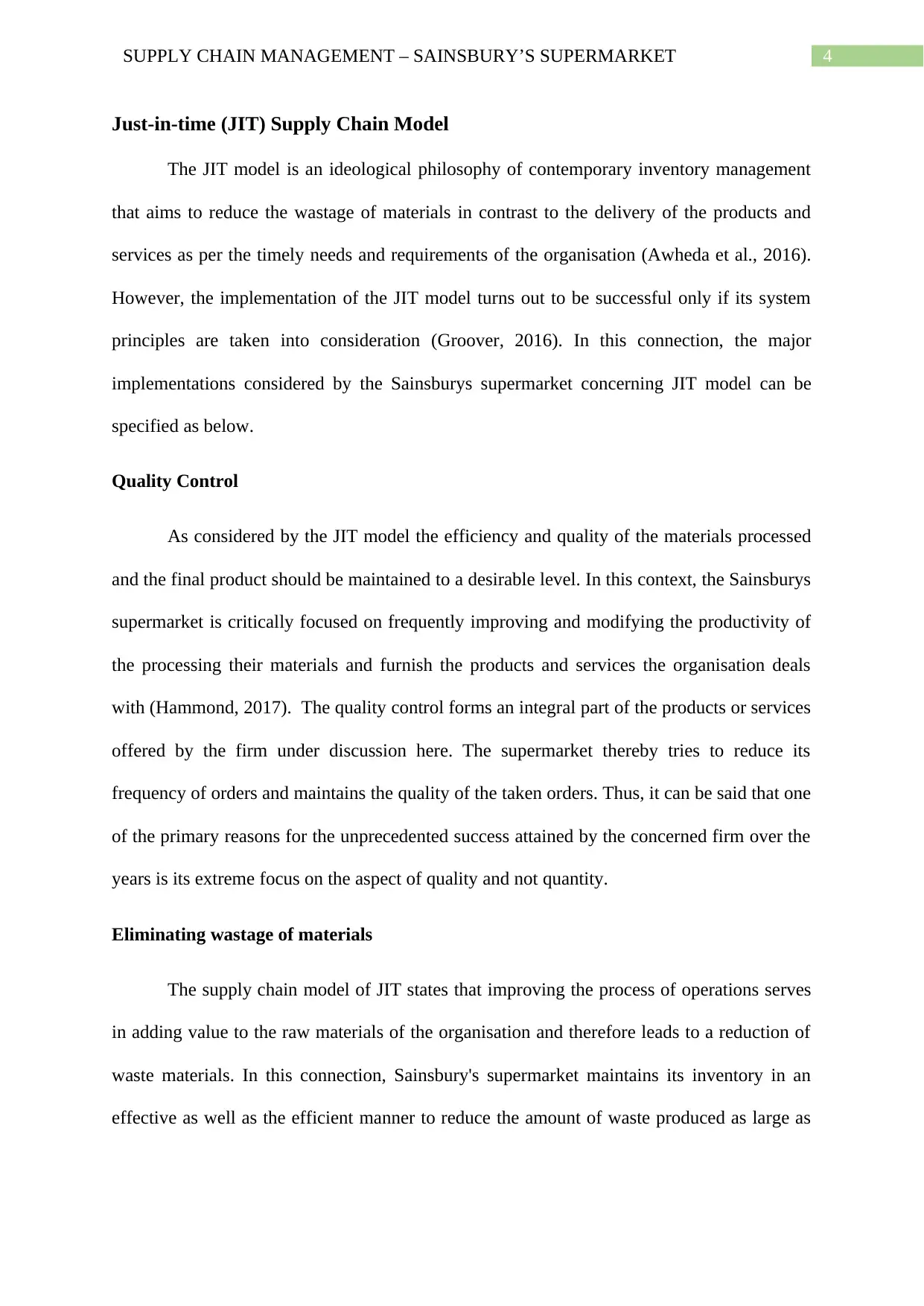
4SUPPLY CHAIN MANAGEMENT – SAINSBURY’S SUPERMARKET
Just-in-time (JIT) Supply Chain Model
The JIT model is an ideological philosophy of contemporary inventory management
that aims to reduce the wastage of materials in contrast to the delivery of the products and
services as per the timely needs and requirements of the organisation (Awheda et al., 2016).
However, the implementation of the JIT model turns out to be successful only if its system
principles are taken into consideration (Groover, 2016). In this connection, the major
implementations considered by the Sainsburys supermarket concerning JIT model can be
specified as below.
Quality Control
As considered by the JIT model the efficiency and quality of the materials processed
and the final product should be maintained to a desirable level. In this context, the Sainsburys
supermarket is critically focused on frequently improving and modifying the productivity of
the processing their materials and furnish the products and services the organisation deals
with (Hammond, 2017). The quality control forms an integral part of the products or services
offered by the firm under discussion here. The supermarket thereby tries to reduce its
frequency of orders and maintains the quality of the taken orders. Thus, it can be said that one
of the primary reasons for the unprecedented success attained by the concerned firm over the
years is its extreme focus on the aspect of quality and not quantity.
Eliminating wastage of materials
The supply chain model of JIT states that improving the process of operations serves
in adding value to the raw materials of the organisation and therefore leads to a reduction of
waste materials. In this connection, Sainsbury's supermarket maintains its inventory in an
effective as well as the efficient manner to reduce the amount of waste produced as large as
Just-in-time (JIT) Supply Chain Model
The JIT model is an ideological philosophy of contemporary inventory management
that aims to reduce the wastage of materials in contrast to the delivery of the products and
services as per the timely needs and requirements of the organisation (Awheda et al., 2016).
However, the implementation of the JIT model turns out to be successful only if its system
principles are taken into consideration (Groover, 2016). In this connection, the major
implementations considered by the Sainsburys supermarket concerning JIT model can be
specified as below.
Quality Control
As considered by the JIT model the efficiency and quality of the materials processed
and the final product should be maintained to a desirable level. In this context, the Sainsburys
supermarket is critically focused on frequently improving and modifying the productivity of
the processing their materials and furnish the products and services the organisation deals
with (Hammond, 2017). The quality control forms an integral part of the products or services
offered by the firm under discussion here. The supermarket thereby tries to reduce its
frequency of orders and maintains the quality of the taken orders. Thus, it can be said that one
of the primary reasons for the unprecedented success attained by the concerned firm over the
years is its extreme focus on the aspect of quality and not quantity.
Eliminating wastage of materials
The supply chain model of JIT states that improving the process of operations serves
in adding value to the raw materials of the organisation and therefore leads to a reduction of
waste materials. In this connection, Sainsbury's supermarket maintains its inventory in an
effective as well as the efficient manner to reduce the amount of waste produced as large as
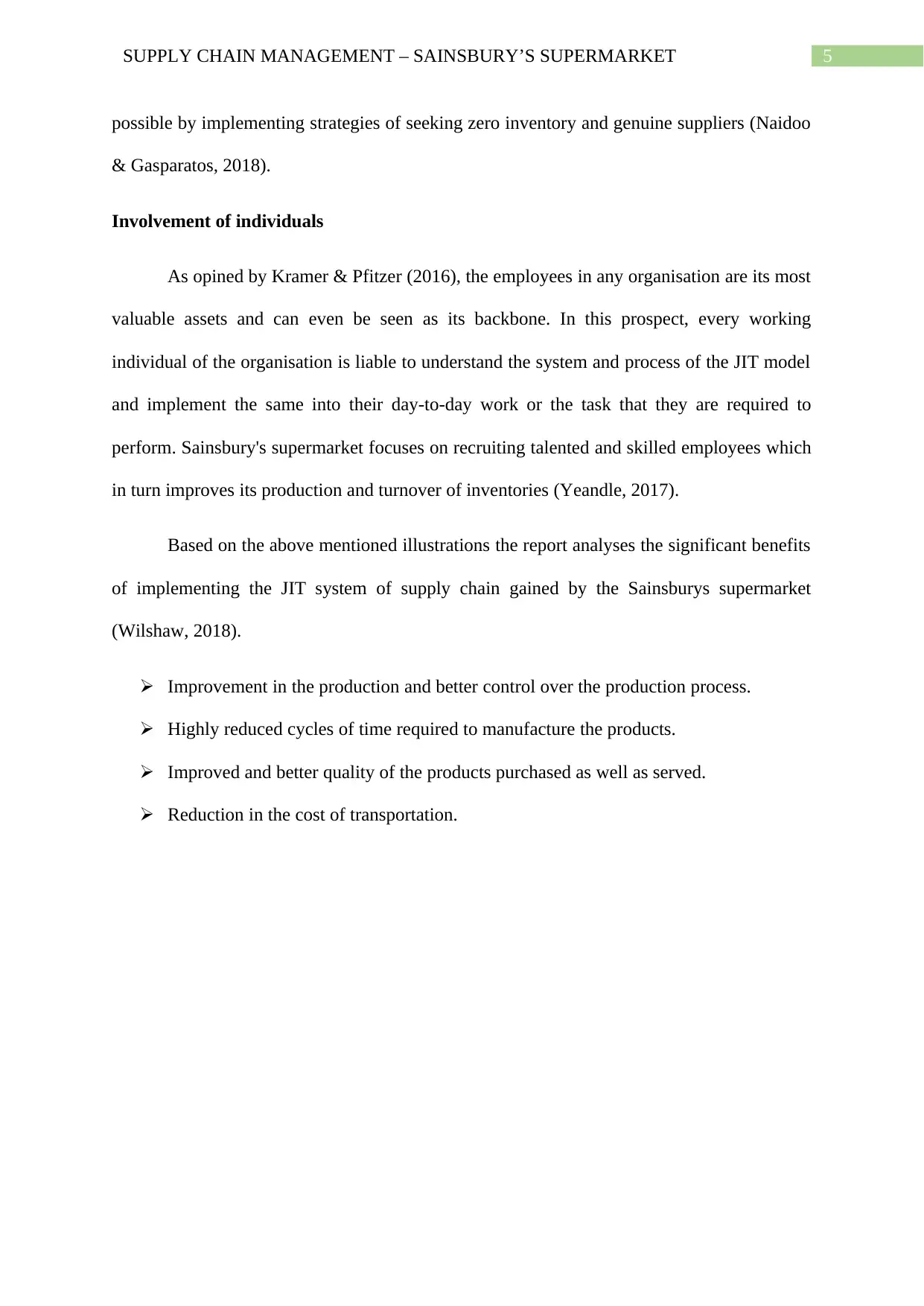
5SUPPLY CHAIN MANAGEMENT – SAINSBURY’S SUPERMARKET
possible by implementing strategies of seeking zero inventory and genuine suppliers (Naidoo
& Gasparatos, 2018).
Involvement of individuals
As opined by Kramer & Pfitzer (2016), the employees in any organisation are its most
valuable assets and can even be seen as its backbone. In this prospect, every working
individual of the organisation is liable to understand the system and process of the JIT model
and implement the same into their day-to-day work or the task that they are required to
perform. Sainsbury's supermarket focuses on recruiting talented and skilled employees which
in turn improves its production and turnover of inventories (Yeandle, 2017).
Based on the above mentioned illustrations the report analyses the significant benefits
of implementing the JIT system of supply chain gained by the Sainsburys supermarket
(Wilshaw, 2018).
Improvement in the production and better control over the production process.
Highly reduced cycles of time required to manufacture the products.
Improved and better quality of the products purchased as well as served.
Reduction in the cost of transportation.
possible by implementing strategies of seeking zero inventory and genuine suppliers (Naidoo
& Gasparatos, 2018).
Involvement of individuals
As opined by Kramer & Pfitzer (2016), the employees in any organisation are its most
valuable assets and can even be seen as its backbone. In this prospect, every working
individual of the organisation is liable to understand the system and process of the JIT model
and implement the same into their day-to-day work or the task that they are required to
perform. Sainsbury's supermarket focuses on recruiting talented and skilled employees which
in turn improves its production and turnover of inventories (Yeandle, 2017).
Based on the above mentioned illustrations the report analyses the significant benefits
of implementing the JIT system of supply chain gained by the Sainsburys supermarket
(Wilshaw, 2018).
Improvement in the production and better control over the production process.
Highly reduced cycles of time required to manufacture the products.
Improved and better quality of the products purchased as well as served.
Reduction in the cost of transportation.
⊘ This is a preview!⊘
Do you want full access?
Subscribe today to unlock all pages.

Trusted by 1+ million students worldwide
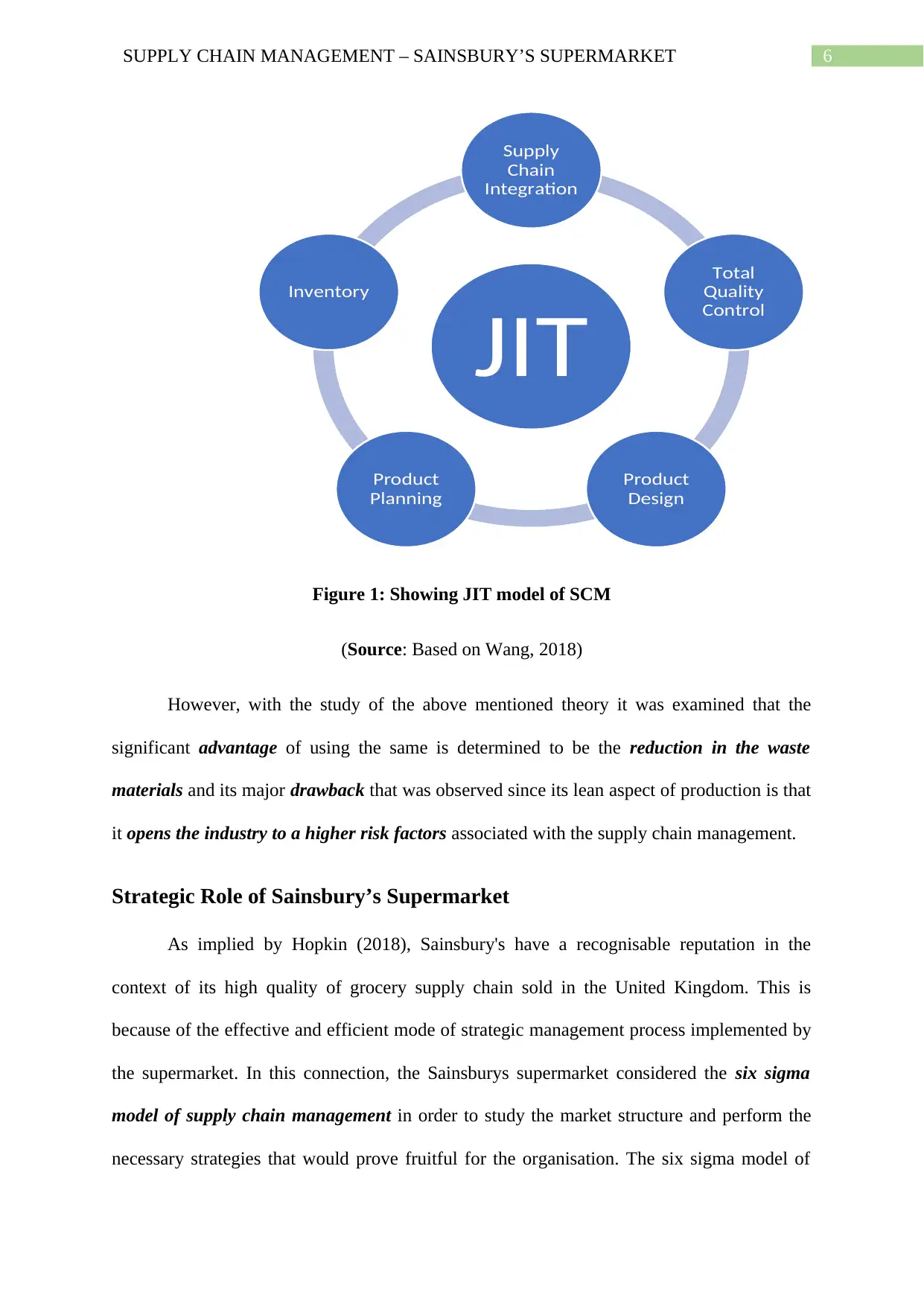
6SUPPLY CHAIN MANAGEMENT – SAINSBURY’S SUPERMARKET
Figure 1: Showing JIT model of SCM
(Source: Based on Wang, 2018)
However, with the study of the above mentioned theory it was examined that the
significant advantage of using the same is determined to be the reduction in the waste
materials and its major drawback that was observed since its lean aspect of production is that
it opens the industry to a higher risk factors associated with the supply chain management.
Strategic Role of Sainsbury’s Supermarket
As implied by Hopkin (2018), Sainsbury's have a recognisable reputation in the
context of its high quality of grocery supply chain sold in the United Kingdom. This is
because of the effective and efficient mode of strategic management process implemented by
the supermarket. In this connection, the Sainsburys supermarket considered the six sigma
model of supply chain management in order to study the market structure and perform the
necessary strategies that would prove fruitful for the organisation. The six sigma model of
JIT
Supply
Chain
Integration
Total
Quality
Control
Product
Design
Product
Planning
Inventory
Figure 1: Showing JIT model of SCM
(Source: Based on Wang, 2018)
However, with the study of the above mentioned theory it was examined that the
significant advantage of using the same is determined to be the reduction in the waste
materials and its major drawback that was observed since its lean aspect of production is that
it opens the industry to a higher risk factors associated with the supply chain management.
Strategic Role of Sainsbury’s Supermarket
As implied by Hopkin (2018), Sainsbury's have a recognisable reputation in the
context of its high quality of grocery supply chain sold in the United Kingdom. This is
because of the effective and efficient mode of strategic management process implemented by
the supermarket. In this connection, the Sainsburys supermarket considered the six sigma
model of supply chain management in order to study the market structure and perform the
necessary strategies that would prove fruitful for the organisation. The six sigma model of
JIT
Supply
Chain
Integration
Total
Quality
Control
Product
Design
Product
Planning
Inventory
Paraphrase This Document
Need a fresh take? Get an instant paraphrase of this document with our AI Paraphraser
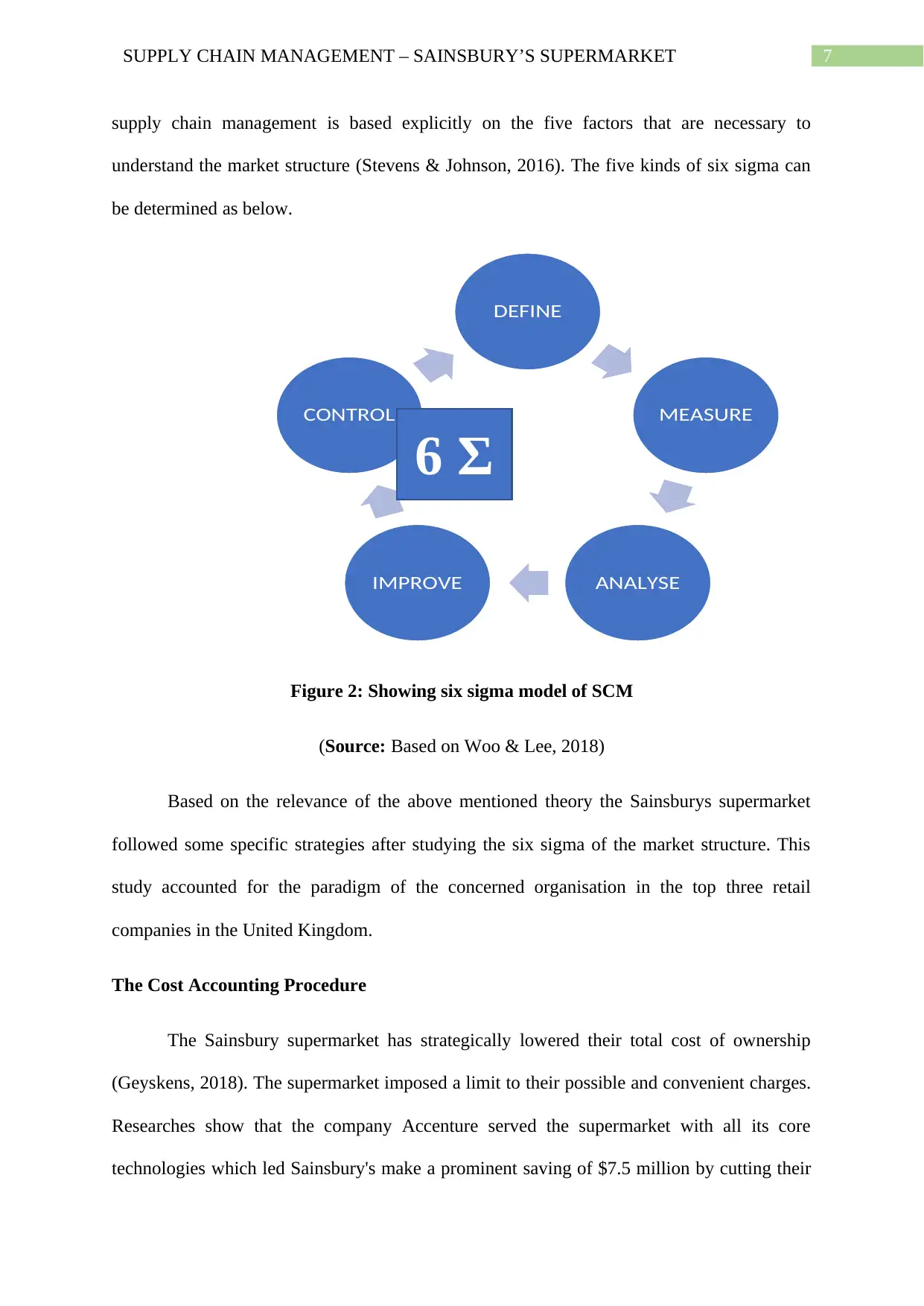
7SUPPLY CHAIN MANAGEMENT – SAINSBURY’S SUPERMARKET
supply chain management is based explicitly on the five factors that are necessary to
understand the market structure (Stevens & Johnson, 2016). The five kinds of six sigma can
be determined as below.
Figure 2: Showing six sigma model of SCM
(Source: Based on Woo & Lee, 2018)
Based on the relevance of the above mentioned theory the Sainsburys supermarket
followed some specific strategies after studying the six sigma of the market structure. This
study accounted for the paradigm of the concerned organisation in the top three retail
companies in the United Kingdom.
The Cost Accounting Procedure
The Sainsbury supermarket has strategically lowered their total cost of ownership
(Geyskens, 2018). The supermarket imposed a limit to their possible and convenient charges.
Researches show that the company Accenture served the supermarket with all its core
technologies which led Sainsbury's make a prominent saving of $7.5 million by cutting their
DEFINE
MEASURE
ANALYSEIMPROVE
CONTROL
6 Σ
supply chain management is based explicitly on the five factors that are necessary to
understand the market structure (Stevens & Johnson, 2016). The five kinds of six sigma can
be determined as below.
Figure 2: Showing six sigma model of SCM
(Source: Based on Woo & Lee, 2018)
Based on the relevance of the above mentioned theory the Sainsburys supermarket
followed some specific strategies after studying the six sigma of the market structure. This
study accounted for the paradigm of the concerned organisation in the top three retail
companies in the United Kingdom.
The Cost Accounting Procedure
The Sainsbury supermarket has strategically lowered their total cost of ownership
(Geyskens, 2018). The supermarket imposed a limit to their possible and convenient charges.
Researches show that the company Accenture served the supermarket with all its core
technologies which led Sainsbury's make a prominent saving of $7.5 million by cutting their
DEFINE
MEASURE
ANALYSEIMPROVE
CONTROL
6 Σ
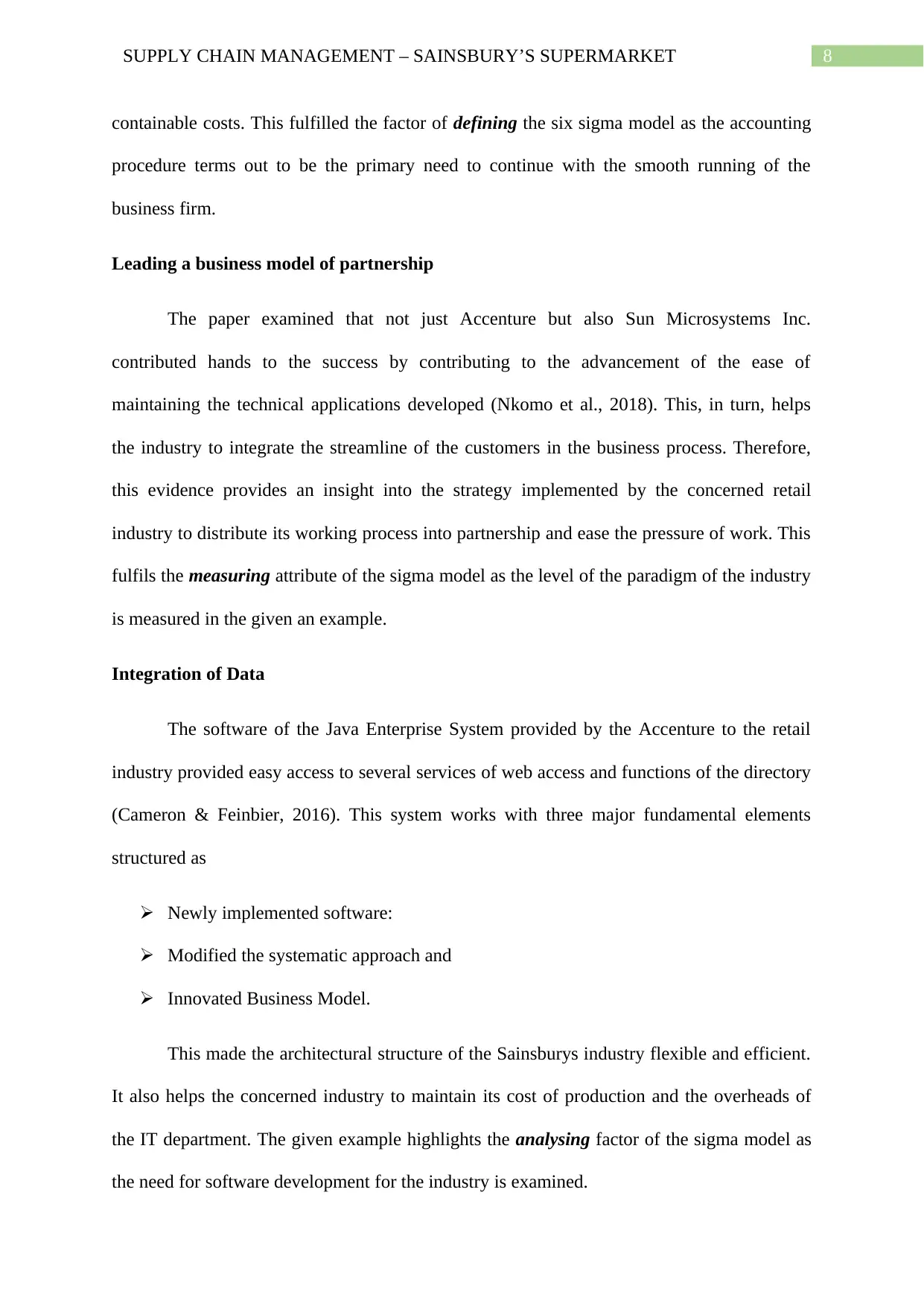
8SUPPLY CHAIN MANAGEMENT – SAINSBURY’S SUPERMARKET
containable costs. This fulfilled the factor of defining the six sigma model as the accounting
procedure terms out to be the primary need to continue with the smooth running of the
business firm.
Leading a business model of partnership
The paper examined that not just Accenture but also Sun Microsystems Inc.
contributed hands to the success by contributing to the advancement of the ease of
maintaining the technical applications developed (Nkomo et al., 2018). This, in turn, helps
the industry to integrate the streamline of the customers in the business process. Therefore,
this evidence provides an insight into the strategy implemented by the concerned retail
industry to distribute its working process into partnership and ease the pressure of work. This
fulfils the measuring attribute of the sigma model as the level of the paradigm of the industry
is measured in the given an example.
Integration of Data
The software of the Java Enterprise System provided by the Accenture to the retail
industry provided easy access to several services of web access and functions of the directory
(Cameron & Feinbier, 2016). This system works with three major fundamental elements
structured as
Newly implemented software:
Modified the systematic approach and
Innovated Business Model.
This made the architectural structure of the Sainsburys industry flexible and efficient.
It also helps the concerned industry to maintain its cost of production and the overheads of
the IT department. The given example highlights the analysing factor of the sigma model as
the need for software development for the industry is examined.
containable costs. This fulfilled the factor of defining the six sigma model as the accounting
procedure terms out to be the primary need to continue with the smooth running of the
business firm.
Leading a business model of partnership
The paper examined that not just Accenture but also Sun Microsystems Inc.
contributed hands to the success by contributing to the advancement of the ease of
maintaining the technical applications developed (Nkomo et al., 2018). This, in turn, helps
the industry to integrate the streamline of the customers in the business process. Therefore,
this evidence provides an insight into the strategy implemented by the concerned retail
industry to distribute its working process into partnership and ease the pressure of work. This
fulfils the measuring attribute of the sigma model as the level of the paradigm of the industry
is measured in the given an example.
Integration of Data
The software of the Java Enterprise System provided by the Accenture to the retail
industry provided easy access to several services of web access and functions of the directory
(Cameron & Feinbier, 2016). This system works with three major fundamental elements
structured as
Newly implemented software:
Modified the systematic approach and
Innovated Business Model.
This made the architectural structure of the Sainsburys industry flexible and efficient.
It also helps the concerned industry to maintain its cost of production and the overheads of
the IT department. The given example highlights the analysing factor of the sigma model as
the need for software development for the industry is examined.
⊘ This is a preview!⊘
Do you want full access?
Subscribe today to unlock all pages.

Trusted by 1+ million students worldwide
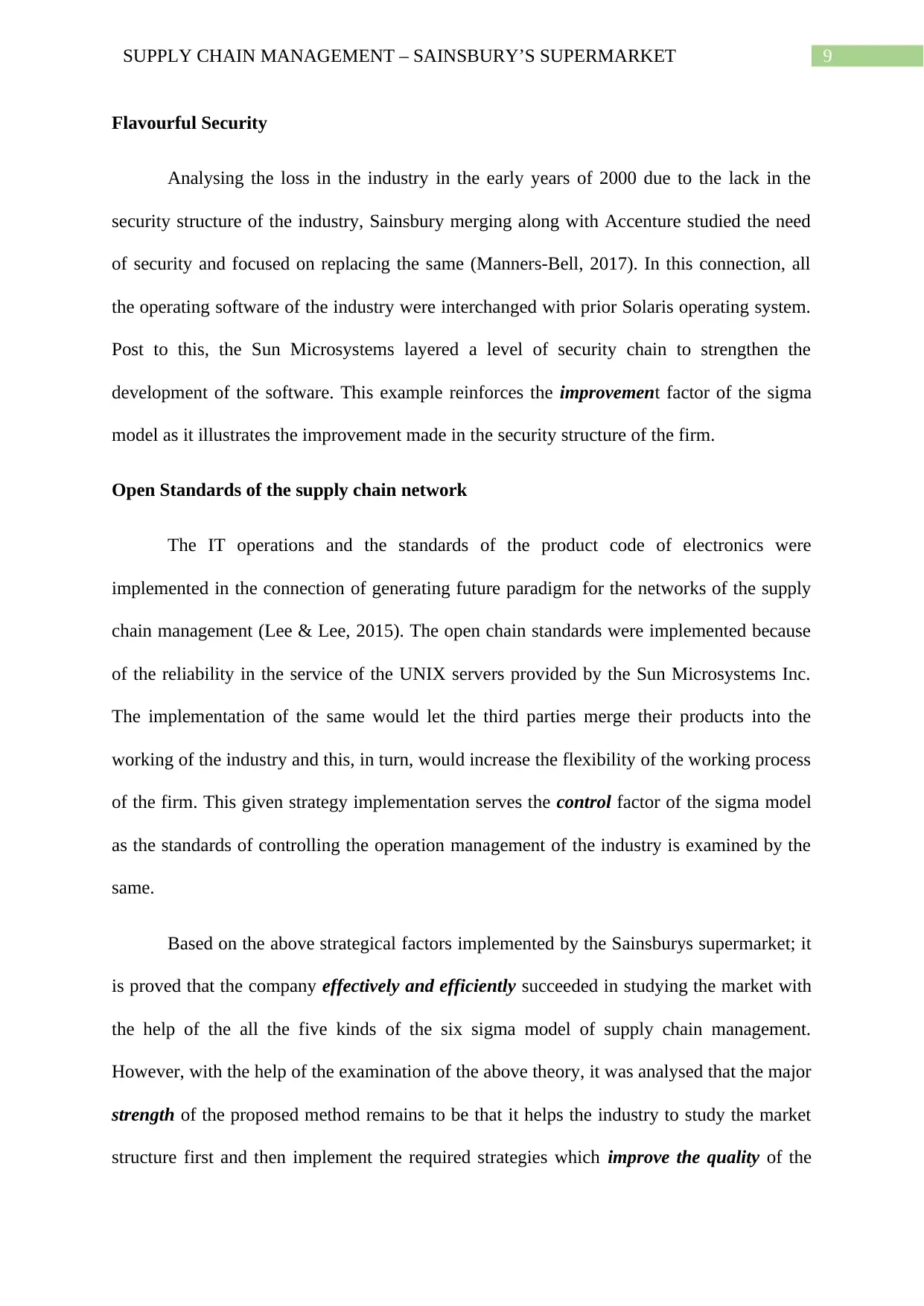
9SUPPLY CHAIN MANAGEMENT – SAINSBURY’S SUPERMARKET
Flavourful Security
Analysing the loss in the industry in the early years of 2000 due to the lack in the
security structure of the industry, Sainsbury merging along with Accenture studied the need
of security and focused on replacing the same (Manners-Bell, 2017). In this connection, all
the operating software of the industry were interchanged with prior Solaris operating system.
Post to this, the Sun Microsystems layered a level of security chain to strengthen the
development of the software. This example reinforces the improvement factor of the sigma
model as it illustrates the improvement made in the security structure of the firm.
Open Standards of the supply chain network
The IT operations and the standards of the product code of electronics were
implemented in the connection of generating future paradigm for the networks of the supply
chain management (Lee & Lee, 2015). The open chain standards were implemented because
of the reliability in the service of the UNIX servers provided by the Sun Microsystems Inc.
The implementation of the same would let the third parties merge their products into the
working of the industry and this, in turn, would increase the flexibility of the working process
of the firm. This given strategy implementation serves the control factor of the sigma model
as the standards of controlling the operation management of the industry is examined by the
same.
Based on the above strategical factors implemented by the Sainsburys supermarket; it
is proved that the company effectively and efficiently succeeded in studying the market with
the help of the all the five kinds of the six sigma model of supply chain management.
However, with the help of the examination of the above theory, it was analysed that the major
strength of the proposed method remains to be that it helps the industry to study the market
structure first and then implement the required strategies which improve the quality of the
Flavourful Security
Analysing the loss in the industry in the early years of 2000 due to the lack in the
security structure of the industry, Sainsbury merging along with Accenture studied the need
of security and focused on replacing the same (Manners-Bell, 2017). In this connection, all
the operating software of the industry were interchanged with prior Solaris operating system.
Post to this, the Sun Microsystems layered a level of security chain to strengthen the
development of the software. This example reinforces the improvement factor of the sigma
model as it illustrates the improvement made in the security structure of the firm.
Open Standards of the supply chain network
The IT operations and the standards of the product code of electronics were
implemented in the connection of generating future paradigm for the networks of the supply
chain management (Lee & Lee, 2015). The open chain standards were implemented because
of the reliability in the service of the UNIX servers provided by the Sun Microsystems Inc.
The implementation of the same would let the third parties merge their products into the
working of the industry and this, in turn, would increase the flexibility of the working process
of the firm. This given strategy implementation serves the control factor of the sigma model
as the standards of controlling the operation management of the industry is examined by the
same.
Based on the above strategical factors implemented by the Sainsburys supermarket; it
is proved that the company effectively and efficiently succeeded in studying the market with
the help of the all the five kinds of the six sigma model of supply chain management.
However, with the help of the examination of the above theory, it was analysed that the major
strength of the proposed method remains to be that it helps the industry to study the market
structure first and then implement the required strategies which improve the quality of the
Paraphrase This Document
Need a fresh take? Get an instant paraphrase of this document with our AI Paraphraser
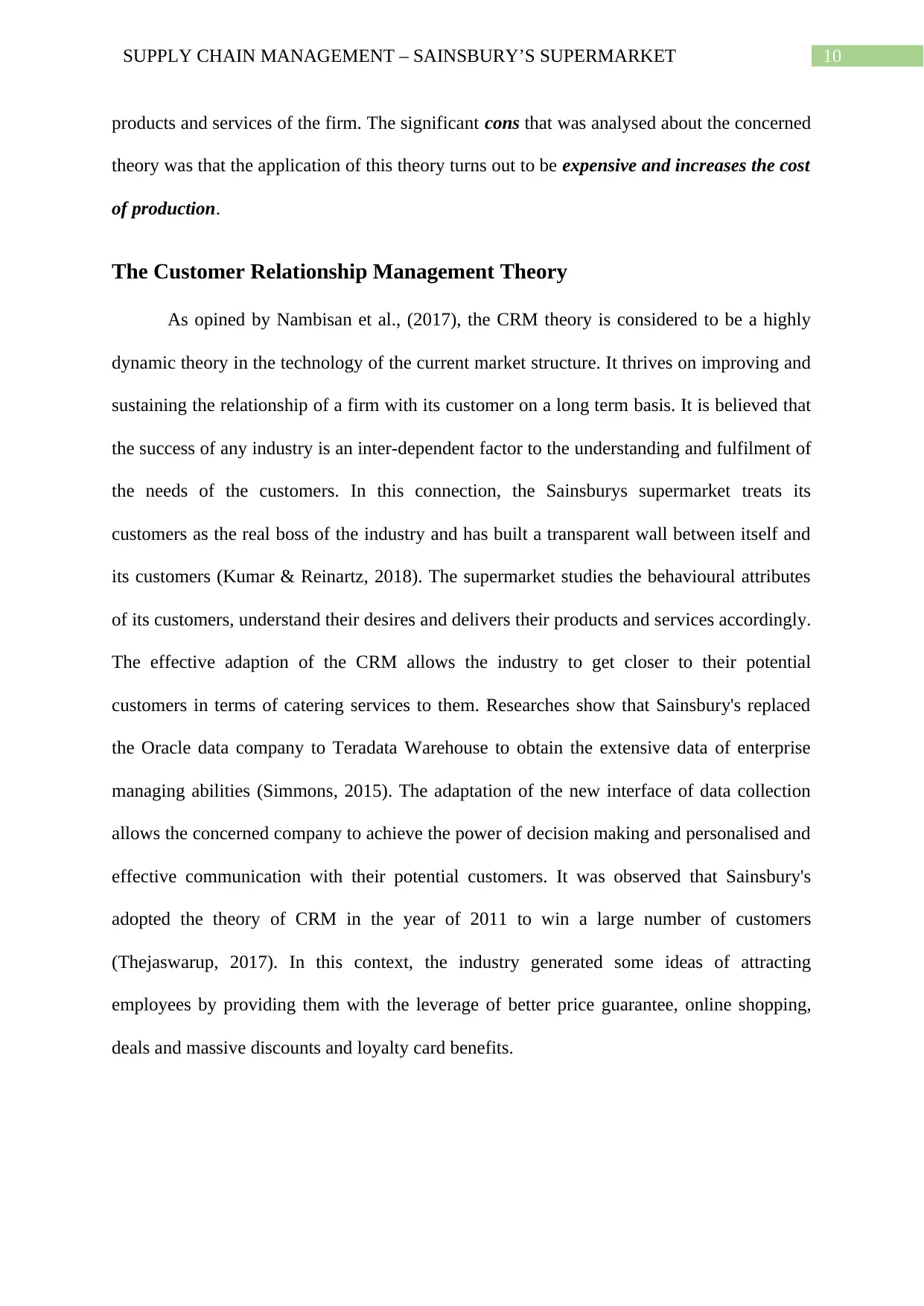
10SUPPLY CHAIN MANAGEMENT – SAINSBURY’S SUPERMARKET
products and services of the firm. The significant cons that was analysed about the concerned
theory was that the application of this theory turns out to be expensive and increases the cost
of production.
The Customer Relationship Management Theory
As opined by Nambisan et al., (2017), the CRM theory is considered to be a highly
dynamic theory in the technology of the current market structure. It thrives on improving and
sustaining the relationship of a firm with its customer on a long term basis. It is believed that
the success of any industry is an inter-dependent factor to the understanding and fulfilment of
the needs of the customers. In this connection, the Sainsburys supermarket treats its
customers as the real boss of the industry and has built a transparent wall between itself and
its customers (Kumar & Reinartz, 2018). The supermarket studies the behavioural attributes
of its customers, understand their desires and delivers their products and services accordingly.
The effective adaption of the CRM allows the industry to get closer to their potential
customers in terms of catering services to them. Researches show that Sainsbury's replaced
the Oracle data company to Teradata Warehouse to obtain the extensive data of enterprise
managing abilities (Simmons, 2015). The adaptation of the new interface of data collection
allows the concerned company to achieve the power of decision making and personalised and
effective communication with their potential customers. It was observed that Sainsbury's
adopted the theory of CRM in the year of 2011 to win a large number of customers
(Thejaswarup, 2017). In this context, the industry generated some ideas of attracting
employees by providing them with the leverage of better price guarantee, online shopping,
deals and massive discounts and loyalty card benefits.
products and services of the firm. The significant cons that was analysed about the concerned
theory was that the application of this theory turns out to be expensive and increases the cost
of production.
The Customer Relationship Management Theory
As opined by Nambisan et al., (2017), the CRM theory is considered to be a highly
dynamic theory in the technology of the current market structure. It thrives on improving and
sustaining the relationship of a firm with its customer on a long term basis. It is believed that
the success of any industry is an inter-dependent factor to the understanding and fulfilment of
the needs of the customers. In this connection, the Sainsburys supermarket treats its
customers as the real boss of the industry and has built a transparent wall between itself and
its customers (Kumar & Reinartz, 2018). The supermarket studies the behavioural attributes
of its customers, understand their desires and delivers their products and services accordingly.
The effective adaption of the CRM allows the industry to get closer to their potential
customers in terms of catering services to them. Researches show that Sainsbury's replaced
the Oracle data company to Teradata Warehouse to obtain the extensive data of enterprise
managing abilities (Simmons, 2015). The adaptation of the new interface of data collection
allows the concerned company to achieve the power of decision making and personalised and
effective communication with their potential customers. It was observed that Sainsbury's
adopted the theory of CRM in the year of 2011 to win a large number of customers
(Thejaswarup, 2017). In this context, the industry generated some ideas of attracting
employees by providing them with the leverage of better price guarantee, online shopping,
deals and massive discounts and loyalty card benefits.
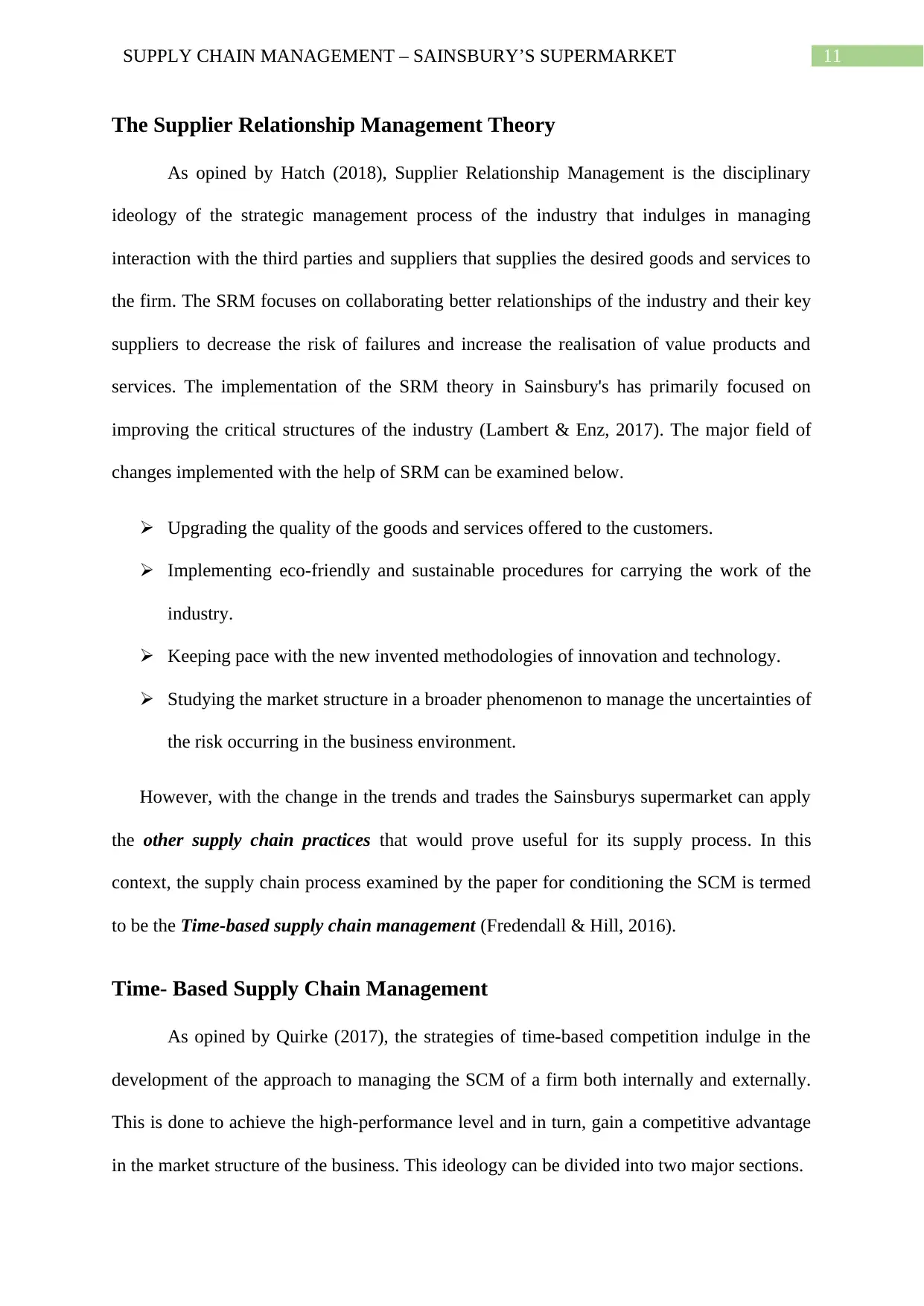
11SUPPLY CHAIN MANAGEMENT – SAINSBURY’S SUPERMARKET
The Supplier Relationship Management Theory
As opined by Hatch (2018), Supplier Relationship Management is the disciplinary
ideology of the strategic management process of the industry that indulges in managing
interaction with the third parties and suppliers that supplies the desired goods and services to
the firm. The SRM focuses on collaborating better relationships of the industry and their key
suppliers to decrease the risk of failures and increase the realisation of value products and
services. The implementation of the SRM theory in Sainsbury's has primarily focused on
improving the critical structures of the industry (Lambert & Enz, 2017). The major field of
changes implemented with the help of SRM can be examined below.
Upgrading the quality of the goods and services offered to the customers.
Implementing eco-friendly and sustainable procedures for carrying the work of the
industry.
Keeping pace with the new invented methodologies of innovation and technology.
Studying the market structure in a broader phenomenon to manage the uncertainties of
the risk occurring in the business environment.
However, with the change in the trends and trades the Sainsburys supermarket can apply
the other supply chain practices that would prove useful for its supply process. In this
context, the supply chain process examined by the paper for conditioning the SCM is termed
to be the Time-based supply chain management (Fredendall & Hill, 2016).
Time- Based Supply Chain Management
As opined by Quirke (2017), the strategies of time-based competition indulge in the
development of the approach to managing the SCM of a firm both internally and externally.
This is done to achieve the high-performance level and in turn, gain a competitive advantage
in the market structure of the business. This ideology can be divided into two major sections.
The Supplier Relationship Management Theory
As opined by Hatch (2018), Supplier Relationship Management is the disciplinary
ideology of the strategic management process of the industry that indulges in managing
interaction with the third parties and suppliers that supplies the desired goods and services to
the firm. The SRM focuses on collaborating better relationships of the industry and their key
suppliers to decrease the risk of failures and increase the realisation of value products and
services. The implementation of the SRM theory in Sainsbury's has primarily focused on
improving the critical structures of the industry (Lambert & Enz, 2017). The major field of
changes implemented with the help of SRM can be examined below.
Upgrading the quality of the goods and services offered to the customers.
Implementing eco-friendly and sustainable procedures for carrying the work of the
industry.
Keeping pace with the new invented methodologies of innovation and technology.
Studying the market structure in a broader phenomenon to manage the uncertainties of
the risk occurring in the business environment.
However, with the change in the trends and trades the Sainsburys supermarket can apply
the other supply chain practices that would prove useful for its supply process. In this
context, the supply chain process examined by the paper for conditioning the SCM is termed
to be the Time-based supply chain management (Fredendall & Hill, 2016).
Time- Based Supply Chain Management
As opined by Quirke (2017), the strategies of time-based competition indulge in the
development of the approach to managing the SCM of a firm both internally and externally.
This is done to achieve the high-performance level and in turn, gain a competitive advantage
in the market structure of the business. This ideology can be divided into two major sections.
⊘ This is a preview!⊘
Do you want full access?
Subscribe today to unlock all pages.

Trusted by 1+ million students worldwide
1 out of 18
Related Documents
Your All-in-One AI-Powered Toolkit for Academic Success.
+13062052269
info@desklib.com
Available 24*7 on WhatsApp / Email
![[object Object]](/_next/static/media/star-bottom.7253800d.svg)
Unlock your academic potential
Copyright © 2020–2025 A2Z Services. All Rights Reserved. Developed and managed by ZUCOL.





